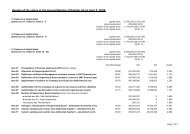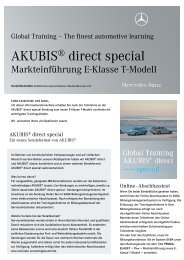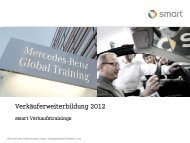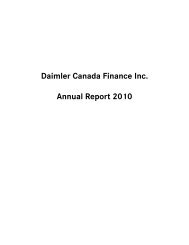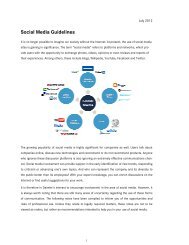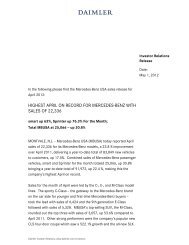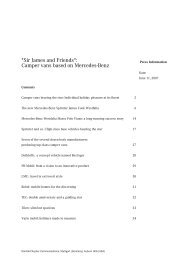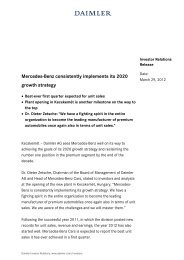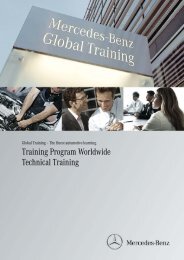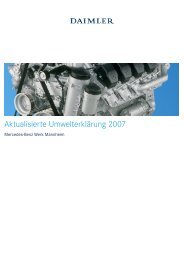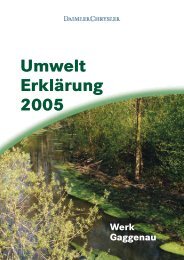Folie 1 - Daimler
Folie 1 - Daimler
Folie 1 - Daimler
Create successful ePaper yourself
Turn your PDF publications into a flip-book with our unique Google optimized e-Paper software.
The Electrification of the Automobile<br />
- Technical and economic challenges<br />
Dr. Christian Mohrdieck<br />
Director<br />
Fuel Cell & Battery Drive Development
Global Trends<br />
100<br />
Limited Resources<br />
$/barrel<br />
80<br />
60<br />
40<br />
20<br />
E.g.: Oil Price<br />
?<br />
04/08: $118<br />
1950 2000 2050<br />
Dr. Christian Mohrdieck, 090610<br />
Inhabitants (in Mio.)<br />
Creeping Mobility<br />
Megacities Top 5 Ranking<br />
1900 2003 2015<br />
London 6,5<br />
New York 5,5<br />
Tokio 5,2<br />
Paris 4,0<br />
Berlin 2,4<br />
Source: Bronger (1996)<br />
Tokio 35,0<br />
Mexico City 18,7<br />
New York 18,3<br />
Sao Paulo 17,9<br />
Bombay 17,4<br />
Tokio 36,2<br />
Bombay 22,6<br />
Delhi 20,9<br />
Mexico City 20,6<br />
Sao Paulo 20,0<br />
Law / Legislation<br />
City-Maut London<br />
Daily Fee:<br />
8 £
World crude-oil deposits: 179 bn tons<br />
Annual oil consumption: 3,9 bn tons<br />
5,6 km<br />
Limited crude-oil resources:<br />
We are aware of our responsibility!<br />
Average water content of<br />
Lake Geneva: 89 bn tons<br />
Crude Oil<br />
5,6 km<br />
5,6 km 5,6 km<br />
Dr. Christian Mohrdieck, 090610<br />
Crude Oil<br />
1,6 km<br />
Data: Exxonmobil 2007<br />
a cube with a side length of 5.6 km<br />
a cube with a side length of 1.6 km<br />
We need strategies and technologies 1,6 km to reduce<br />
5,6 km<br />
consumption and Data: emissions<br />
Exxonmobil 2007<br />
5,6 km<br />
The Current CO 2 – Debate<br />
Theoretical annual<br />
decrease of water level: 7m<br />
-7m
Worldwide emission regulations necessitate new<br />
power train technologies<br />
CV: NOx and Particle<br />
PC: Fuel Consumption CAFE 1 :<br />
�≥ 30 mpg for MY2012 7,8<br />
l/100km<br />
Fuel Consumption CARB 2 :<br />
AB1493 � 205 g CO 2/mi<br />
for MY2016 (= 127 g CO 2/km)<br />
Emission: focus NOx reduction!<br />
� BIN8: 0,14 g/km NOx<br />
� BIN5: 0,07 g/mi NOx<br />
� SULEV: 0,02 g/mi NOx<br />
ZEV & AT-PZEV Mandate !<br />
1 50 states; 2 5+ X states<br />
Dr. Christian Mohrdieck, 090610<br />
Fuel Consumption:<br />
� Oriented on CARB<br />
Emission:<br />
� Oriented on EPA*<br />
~ 5,3<br />
l/100km<br />
*Environmental Protection Agency<br />
CV: NOx and Particle<br />
PC: Fuel Consumption:<br />
� 140 g CO 2 /km in 2008<br />
� 120 g CO 2 /km in 2012<br />
Emission: EU5 in 2009<br />
� 0,18* g/km NOx<br />
* Final decision pending<br />
§<br />
~ 5,0<br />
l/100km<br />
CV: NOx and Particle<br />
PC: Fuel Consumption:<br />
� weight classes in 2010<br />
Emission: Urban NOx Control<br />
� 0,14 g/km NOx in 2007<br />
� J-LEV Program<br />
Fuel Consumption:<br />
� 16 weight classes in 2008:<br />
from 43 mpg to 21 mpg<br />
Emission: EU oriented<br />
� EU4 in 2006<br />
5,5-13,9<br />
l/100km
Diverse Individual National Regulations:<br />
Difficult to manage by OEMs. Therefore <strong>Daimler</strong> pursues and<br />
supports the harmonization of standards and regulations!<br />
Euro bzw Euro/Jahr<br />
7000<br />
6000<br />
5000<br />
4000<br />
3000<br />
2000<br />
1000<br />
Euro bzw Euro<br />
600<br />
400<br />
200<br />
-200<br />
-400<br />
-600<br />
-800<br />
-1000<br />
Belgium CO 2-related taxes<br />
Euro bzw Euro/Jahr<br />
Benziner<br />
6000<br />
Diesel<br />
5000<br />
4000<br />
3000<br />
0<br />
100 120<br />
2000<br />
140 160<br />
140-141g<br />
=> 710€<br />
180 200 220 240<br />
g CO2/km<br />
14000<br />
260<br />
1000<br />
-1000<br />
Netherlands-Diesel<br />
Niederlande - Diesel<br />
W204 Diesel<br />
156-157g<br />
France - Diesel & Gasoline<br />
0<br />
10000<br />
P - CO2 Gas Car Tax<br />
P - CO2 12000 Diesel Car Tax<br />
100 120 140 160 180 200 220 240 260<br />
0<br />
100 120 140 160 180 200 220 240 260<br />
Dr. Christian Mohrdieck, 090610<br />
W211 Diesel<br />
173-174g<br />
160-161g<br />
=> 815€<br />
grünes Label C und kein<br />
Bonus/Malus bei 0€<br />
200-201g<br />
=> 417€<br />
Euro bzw Euro/Jahr<br />
NL - 2007 W204Diesel-Gesch.&Priv.<br />
NL - 2007 W211Diesel-Gesch.&Priv.<br />
12000<br />
8000<br />
6000<br />
4000<br />
2000<br />
g CO2/km<br />
250-251g<br />
=> 519€<br />
F - CO2 Car Tax Biz only<br />
Portugal - ISV (Imposto Sobre Veiculos)<br />
Euro bzw Euro/Jahr<br />
10000<br />
8000<br />
6000<br />
4000<br />
g CO2/km<br />
Austria Österreich (NoVa (NoVa new neu + Bonus/Malus<br />
Bonus/Malus)<br />
g CO2/km<br />
0<br />
100 120 140 160 180<br />
12000<br />
200 220 240 260<br />
2000<br />
Benziner NoVa + Bonus-Malus<br />
Diesel NoVa + Bonus-Malus<br />
Euro/Jahr<br />
18000<br />
16000<br />
14000<br />
10000<br />
UK - Diesel (Commercial Accounts)<br />
0<br />
8000<br />
g CO2/km<br />
100 120 140 160 180 200 220 240 260<br />
6000<br />
4000<br />
2000<br />
UK - Diesel Car Ownership Tax Priv/Biz<br />
UK - Diesel Biz bik (benefit in kind)<br />
Regulations and Policies<br />
National Levers:<br />
•Tax incentives (e.g. France)<br />
•Extremely high taxation (e.g. UK)<br />
•Labeling (e.g. Netherlands)<br />
UK - Diesel Biz bik + Car Tax + LCC(2009)<br />
planned 2009<br />
225g - 226g<br />
=> 6150€<br />
London Congestion Charge<br />
+ Ownership tax<br />
+ Benefit in kind (biz)<br />
Benefit in kind (biz)<br />
+ Ownership tax<br />
Ownership tax<br />
0<br />
100 120 140 160 180 200 220 240 g CO2/km 260<br />
5
Trend Of Driving Performance and Emissions<br />
700%<br />
600%<br />
500%<br />
400%<br />
300%<br />
200%<br />
100%<br />
0%<br />
Road Straßenverkehr Traffic Germany Deutschland<br />
Emission Legislation PC<br />
Emission Legislation CV<br />
Launch<br />
TWC (Three Way Catalyst)<br />
CO<br />
HC<br />
EURO1<br />
Basis Scenario<br />
Driving Performance<br />
Through several technical improvements, a significant reduction of pollutants has been<br />
achieved whilst the driving performance increased. Also a turnaround on CO 2 emission<br />
has been achieved. (Source: TREMOD)<br />
Dr. Christian Mohrdieck, 090610<br />
1960 1965 1970 1975 1980 1985 1990 1995 2000 2005 2010 2015 2020 2025 2030<br />
EURO2<br />
EURO3<br />
EUO EU1 EURO2 EURO3<br />
EURO4<br />
EURO4<br />
EURO5<br />
Achievements<br />
CO 2<br />
NO x<br />
PM
Sustainable Mobility<br />
Significant improvements in environmental friendliness are decisive<br />
element of our claim to be No. 1<br />
Aspiration: Leadership in “Green Technologies”<br />
Compliant<br />
with<br />
regulations<br />
Over-compliance<br />
regulations<br />
Leadership<br />
in „Green<br />
Technology“<br />
Green<br />
Leadership<br />
Reactive Proactive<br />
Customer advantages<br />
Fuel efficient cars<br />
Eco-friendly brand<br />
In comparison to small car manufacturers our product portfolio allows no absolute „Green Leadership“<br />
Dr. Christian Mohrdieck, 090610<br />
Mercedes-Benz Cars<br />
7
Sustainable Mobility<br />
Research & Development budget<br />
Add on for green technology<br />
R&D budget<br />
Fuel economy & environment<br />
•R&D-integration<br />
• CORE<br />
Fuel economy campaign<br />
2001 2002 2003 2004 2005 2006 2007 2008 2009 2010<br />
Dr. Christian Mohrdieck, 090610<br />
Mercedes-Benz Cars<br />
8
Sustainable Mobility<br />
Mercedes-Benz Roadmap<br />
Optimization of our vehicles<br />
with high-tech combustion<br />
engines<br />
BlueEFFICIENCY<br />
CGI, BlueTEC<br />
DIESOTTO<br />
Clean fuels<br />
for combustion engines<br />
Dr. Christian Mohrdieck, 090610<br />
Hybridization for further<br />
increase in efficiency<br />
HYBRID<br />
Range Extender<br />
Plug-In<br />
Energy sources<br />
for the<br />
mobility of the future<br />
Emission-free driving<br />
with fuel-cell/ battery<br />
electric vehicles<br />
H 2<br />
Mercedes-Benz Cars<br />
Fuel cell<br />
Battery-/E-Drive<br />
Emission-free driving<br />
9
<strong>Daimler</strong>’s Roadmap to Sustainable Mobility<br />
today future<br />
Dr. Christian Mohrdieck, 090610<br />
Zero-emission vehicles<br />
with fuel cell/battery drive<br />
Improved & alternative fuels<br />
Efficient cars<br />
with efficient power trains<br />
with or without hybrid modules
Compared to 1990, Mercedes-Benz portfolio has reduced<br />
CO 2–emissions by 30%.<br />
Gasoline Fuel<br />
Consumption<br />
220 hp 231 hp<br />
300 E-24 (1992) E 320 (2006)<br />
Diesel<br />
190 D 2.5 (1993)<br />
Dr. Christian Mohrdieck, 090610<br />
-25%*<br />
CO 2<br />
Fuel<br />
Consumption<br />
-28%*<br />
-55%<br />
Emissions<br />
-70%<br />
-81%<br />
CO HC NOx<br />
-93%<br />
-98%<br />
C 220 CDI (2007)<br />
90 hp CO PM<br />
170 hp<br />
CO 2<br />
Emissions<br />
Achievements
Today 11 models between 4,9 (115 g/km) and<br />
6,5 l/100 km (150 g/km)<br />
Sales volume EU: 20% around 5 l/100km, 38% under 6,5 l/100km<br />
A 150 A 160 CDI A 180 CDI A 200 CDI<br />
B 180 CDI<br />
B 200 CDI C 200 CDI C 220 CDI<br />
CLK 220 CDI E 200 CDI E 220 CDI<br />
Dr. Christian Mohrdieck, 090610<br />
88g CO 2 /km<br />
CO 2 –World Champion and most-sold 3-liter car<br />
Achievements
Origins of CO2 in a Passenger Vehicle<br />
10% Weight<br />
8% other:<br />
Climate<br />
Control,<br />
Electrics,<br />
Steering,<br />
Dr. Christian Mohrdieck, 090610<br />
13%<br />
transmission<br />
12% roll resistance<br />
<strong>Daimler</strong>’s Technology Portfolio<br />
46% Engine<br />
29% physical efficiency<br />
(not optimizable)<br />
17% friction / combustion<br />
process etc.<br />
(optimizable)<br />
11% air<br />
resistance<br />
*) data applies for mid class segment<br />
( 3-Litre gasoline engine | RWD | NEFZ)<br />
13
Continuous improvement in combustion engines:<br />
Potentials for diesel and gasoline engines<br />
Diesel engine<br />
Key technologies:<br />
- Injection system<br />
- Combustion process<br />
- Homogenization<br />
-Turbocharger<br />
- Exhaust gas after-treatment<br />
Target<br />
Dr. Christian Mohrdieck, 090610<br />
Characteristics<br />
☺ Consumption<br />
� Emissions<br />
Roadmap to Sustainable Mobility<br />
Gasoline engine<br />
Key technologies:<br />
- De-throttling<br />
- Direct Injection<br />
-Charging<br />
- Reduction of friction<br />
- Engine cooling management<br />
Gasoline cars as efficient as diesels;<br />
Diesel cars as clean as gasoline cars<br />
Characteristics<br />
☺ Emissions<br />
� Consumption
Three steps towards the cleanest diesel in the world:<br />
Reduction of NO x levels up to 80 percent<br />
Optimization of the engines and<br />
combustion processes,<br />
clean fuels<br />
Oxidizing catalytic converter,<br />
particulate filter<br />
BLUETEC technology<br />
Dr. Christian Mohrdieck, 090610<br />
Minimize untreated<br />
emissions<br />
Minimize emissions of<br />
carbon monoxide,<br />
unburned<br />
hydrocarbons and<br />
particulate matter<br />
Reduces nitrogen<br />
oxide levels up to 80<br />
percent<br />
© <strong>Daimler</strong>
Modular Hybrid Technologies<br />
Powertrain- Integration Energy Storage High-power electronics Hybrid transmission<br />
S 400 HYBRID<br />
with Lithium-Ion Battery<br />
Dr. Christian Mohrdieck, 090610<br />
Bundling of Know-how and Resources<br />
Increased efficiency by Hybridization<br />
ML 450 HYBRID<br />
Two Mode<br />
Citaro G BlueTec Hybrid<br />
City bus<br />
Hybrid Commercial<br />
Vehicle<br />
16
The Potential of Hybridization<br />
S 400 BlueHYBRID<br />
Fuel Economy<br />
NEDC<br />
10,1 l<br />
(242g)<br />
Basis S 350<br />
-17%<br />
Hybrid<br />
Potential<br />
Dr. Christian Mohrdieck, 090610<br />
7,9 l<br />
(190g)<br />
S 400 BlueHYBRID<br />
with Lithium-Ion Battery<br />
Mobility Scenario Hybrid Vehicles:<br />
Mainly in Interurban & Urban Traffic<br />
Key benefits<br />
• Comfortable<br />
Start-stop Technology<br />
• Better Performance<br />
• Recuperation of Braking Energy<br />
• Better Energy Management<br />
• Improved Fuel Efficiency<br />
ML 450 BlueHYBRID<br />
Fuel Economy<br />
NEDC<br />
11,5 l<br />
(275g)<br />
Basis ML 350<br />
-33%<br />
Hybrid<br />
Potential<br />
7,7 l<br />
(185g)<br />
ML 450 BlueHYBRID<br />
with Two Mode
500 <strong>Daimler</strong> Hybrid buses for New York<br />
The largest order for hybrid buses in history<br />
1600 <strong>Daimler</strong> Hybrid buses in North America<br />
Advantages for people and environment:<br />
Urban driving: Compared to standard diesel propulsion, the hybrid units will provide<br />
…significantly better fuel economy (25 - 30 % less),<br />
…greatly reduced emissions<br />
90% less particulate matter<br />
40% less NOx<br />
30% fewer greenhouse gases<br />
…offers faster acceleration<br />
…enables quieter, smoother ride without<br />
the frequent transmission shifts<br />
encountered in conventional buses.<br />
Dr. Christian Mohrdieck, 090610
Fuel Efficiency of different powertrain concepts<br />
Dr. Christian Mohrdieck, 090610<br />
Roadmap to Sustainable Mobility<br />
Hybrid powertrains are beneficial under city driving conditions<br />
Strong Gasoline Hybrids
The future of the combustion engine:<br />
DIESOTTO combines the advantages of both<br />
Gasoline and Diesel engine!<br />
Diesel<br />
Engine<br />
Dr. Christian Mohrdieck, 090610<br />
☺ DIESOTTO<br />
Torque – Power - Consumption – Emissions - Costs<br />
Torque ☺<br />
Consumption ☺<br />
Emissions �<br />
Costs �<br />
190 kW/258 hp inkl. Hybrid<br />
400 Nm<br />
~ 5,3 l/100km (127g CO2)<br />
☺ Emissions<br />
☺ Power<br />
☺ Costs<br />
� Consumption<br />
Gasoline<br />
Engine
The Range of Alternative Powertrains<br />
Energy<br />
source<br />
fuel<br />
Powertrains<br />
Degree of<br />
Fossile:<br />
Otto<br />
Diesel<br />
CNG<br />
Regenerative:<br />
Biofuel<br />
Biogas<br />
Combustion<br />
engines<br />
(Gasoline/Diesel)<br />
Mild<br />
Hybrid<br />
Fossile<br />
Regenerative<br />
Fossile<br />
Nuclear<br />
Regenerative<br />
H2 Electricity<br />
Hybrids Pure electric<br />
driving<br />
„emission-free“<br />
Electrification 100%<br />
0%<br />
Dr. Christian Mohrdieck, 090610<br />
Stop/<br />
Start<br />
(RSG)<br />
Full<br />
Hybrid<br />
Plug-In<br />
Hybrid<br />
(parallel)<br />
Plug-In<br />
Hybrid<br />
(serial/<br />
Range Ext.)<br />
Fuel cell<br />
battery
Global Competence Network:<br />
Fuel Cell- and Battery Electric Vehicles<br />
AFCC<br />
Automotive Fuel Cell<br />
Cooperation<br />
(Vancouver)<br />
F-Cell Stack<br />
Dr. Christian Mohrdieck, 090610 /<br />
Vehicle Dev. &<br />
Production<br />
(Sindelfingen / Rastatt<br />
/ Hambach)<br />
NuCellSys<br />
(Nabern)<br />
F-Cell System<br />
Li-Tec<br />
(Kamenz)<br />
HV-Battery-Cells<br />
GR/AF<br />
Fuel Cell & Battery<br />
Drive Development<br />
(Nabern)<br />
FC- & BEV-Drive Train<br />
+ global supplier network<br />
Deutsche<br />
Accumotive<br />
(Nabern, Kamenz)<br />
HV-Battery<br />
FCV Fuel Cell Vehicle<br />
PHEV Plug-In Hybrid Vehicle<br />
BEV Battery Electric Vehicle<br />
HV High Voltage
Shareholder structure LiTec and Deutsche Accumotive<br />
Li-Tec<br />
Deutsche<br />
Accumotive<br />
Dr. Christian Mohrdieck, 090610<br />
Battery cells<br />
Battery<br />
systems<br />
49,9%<br />
90%<br />
1<br />
2<br />
Deutsche Accumotive<br />
50,1%<br />
Supply/Contribution:<br />
Electrodes, Separators<br />
10%<br />
Batteries<br />
Cooperation with<br />
Tier1 on E/E<br />
23
<strong>Daimler</strong>‘ history on Battery Electric Vehicle<br />
1972<br />
1972 LE 306<br />
1974 1976 1978 1980 1982 1984 1986 1988<br />
Dr. Christian Mohrdieck, 090610<br />
1979 BR 307E<br />
1982 W123<br />
1988 BR 308E<br />
Elektrifizierung der Antriebe<br />
1990 1992 1994 1996 1998 2000 2002 2004 2006 2008<br />
1991 – 1995<br />
W123 + MB100<br />
1993 W202<br />
1995 - 1998<br />
MB 410E<br />
1994 - 1998<br />
W168 A-class<br />
1993 Vision A93<br />
1993ff Transporter<br />
308E + V108E<br />
1998 - ?<br />
BR 451 ev<br />
24
smart Electric Drive London Project<br />
• Demo fleet of 100 smart electric drive on the basis of smart fortwo predecessor model<br />
•Electric drive:<br />
- 30 kW Permanent Magnet-Motor<br />
- Zebra-Battery 15 kWh (NaNiCl)<br />
- Range: ~100 km in EUDC<br />
- max. speed 100 km/h<br />
• Customers:<br />
„ the car is fabulous –<br />
couldn‘t be better!“<br />
Customer‘s voice in London<br />
<strong>Daimler</strong>’s Technology Portfolio<br />
- Fleet customers preferably in city area of London as a 4 year lease model in co-operation with MB UK<br />
-smart evis exempt from London congestion charge!<br />
- 70 vehicles delivered with very positive feedback from customers<br />
- End of production July 2008<br />
•Forecast:<br />
- Investigation of other possible pilot projects on basis of the new smart fortwo for European cities<br />
Dr. Christian Mohrdieck, 090610<br />
25
Technical Data of next generation Smart electric drive<br />
Dr. Christian Mohrdieck, 090610<br />
Technical Data<br />
Vehicle Type Smart fortwo (BR451)<br />
Electric engine<br />
Output (Continuous / Peak):<br />
Engine<br />
35 kW / 50 kW<br />
Max. Torque : 130 Nm<br />
Consumption ~ 13 kWh / 100km<br />
Range 150 km (100 miles)<br />
Top speed 125 km/h (78 mph)<br />
Acceleration 11,5 s (0-100 km/h)<br />
Li-Io-Battery,<br />
Battery Output (Continuous / Peak):<br />
35 kW / 55 kW; Capacity: 17.6 kWh
Challenges for the Battery Technology<br />
Technology<br />
• Power Density<br />
• Energy Density<br />
• Lifetime<br />
(Calendar & Cycle)<br />
• Fast charge capab.<br />
• Low temp. power<br />
Dr. Christian Mohrdieck, 090610<br />
Cost<br />
• Materials<br />
• Electric Drive<br />
• (Power) Electronics<br />
• Infrastructure<br />
• Cooling<br />
3. Trends & Influences<br />
Infrastructure<br />
• Reliable technology<br />
• Production at<br />
Competitive Cost<br />
• In-time Availability<br />
• Sufficient Coverage
Battery Cost<br />
Battery (System) Cost for Electric Vehicle at 20.000 units/a<br />
16.000<br />
14.000<br />
12.000<br />
10.000<br />
8.000<br />
6.000<br />
4.000<br />
2.000<br />
0<br />
Dr. Christian Mohrdieck, 090610<br />
800 €/kWh<br />
650 €/kWh<br />
Limit for > 200.000 u/a<br />
0 2.000 4.000 6.000 8.000 10.000 12.000 14.000 16.000 18.000 20.000<br />
Units/Year<br />
500 €/kWh<br />
300 – 350 €/kWh
GHG* Emissions [g CO 2 eq/km]<br />
Total Energy Balance –<br />
Well-to-Wheel Classification<br />
200<br />
175<br />
150<br />
125<br />
100<br />
75<br />
50<br />
25<br />
Fuel Cell: long range (>400km), short refueling time (3 min), cars/vans/trucks<br />
Battery: ideal in small cars for city traffic (100-150km), overnight recharging<br />
Battery electric vehicle<br />
(Fueled by 100%<br />
renewable electricity)<br />
10<br />
20<br />
30<br />
0 50<br />
100<br />
150<br />
200<br />
240<br />
Energy Consumption Well to Wheel [MJ/100km]<br />
Dr. Christian Mohrdieck, 090610<br />
40<br />
ource: EUCAR/CONCAWE "Well-to-Wheels Report 2004";<br />
ptiresource, 2006 Reference vehicle class: VW Golf<br />
Fuel Cell<br />
(Fueled by 100%<br />
renewable electricity)<br />
60<br />
70<br />
80<br />
90<br />
Fuel Cell<br />
(Fueled by 100%<br />
H2 from fossil sources)<br />
110<br />
120<br />
130<br />
140<br />
Technology<br />
change<br />
160<br />
Internal Combustion Engines<br />
Hybrid<br />
(Diesel)<br />
170<br />
Diesel<br />
Hybrid<br />
(Gasoline)<br />
Fuel Cell<br />
(Fueled by 100%<br />
renewable H2)<br />
180<br />
190<br />
Gasoline<br />
Battery electric vehicle<br />
(Fueled by 100%<br />
electricity from EU-Mix)<br />
210<br />
220<br />
230<br />
*GHG: Green House Gas
Emission-Free Driving:<br />
Fuel-Cell- and Battery-Vehicles<br />
Emission-fees Congested Zero-emission Megacities<br />
urban areas<br />
regions<br />
Fuel Cell Vehicles Battery-electric veh.<br />
~100 F-CELL vehicles<br />
in customer hands<br />
Dr. Christian Mohrdieck, 090610<br />
Enablers<br />
•Technology/components:<br />
•Battery (esp. Li-Ion)<br />
•Fuel-cell stacks<br />
•Hydrogen storage<br />
•Electric engines<br />
•Power electronics<br />
•IP-Rights<br />
•Partnerships<br />
<strong>Daimler</strong>’s Technology Portfolio<br />
~100 smart ev -<br />
test fleet in London<br />
30
Development Process Fuel Cell<br />
Stack System<br />
old: AFCC NuCellSys <strong>Daimler</strong><br />
50/50 DAI/Ford Ford<br />
new: AFCC<br />
50,1 / 30 / 19,9<br />
DAI / F / BPS<br />
Dr. Christian Mohrdieck, 090610<br />
specs<br />
NuCellSys<br />
100% DAI<br />
Drive System<br />
specs specs<br />
Vehicle<br />
<strong>Daimler</strong><br />
Ford<br />
<strong>Daimler</strong> <strong>Daimler</strong><br />
Fuel Cell<br />
31
Experiences with <strong>Daimler</strong> Fuel Cell Vehicles<br />
60 F-Cell vehicles in<br />
Customers’ hands (since 2004)<br />
37 Buses (Citaro)<br />
Europe, Australia, China<br />
3 Light Duty vehicles<br />
at UPS Europe, USA<br />
~ 2.000.000 km* ~ 2.120.000 km* ~ 64.000 km*<br />
<strong>Daimler</strong> is pioneer of Fuel Cell Vehicle (FCV), long experience with FCV’s (first FCV in 1994)<br />
Daily operation of more than 100 FCV’s all over the world<br />
Big variety of FCV’s: Passenger cars, buses, vans<br />
Operation of FCV’s at customers in different climate zones with varying ambient temperatures<br />
In 2007, A-class F-Cell achieved 100,000 miles, 2,500 operating hours without stack failure<br />
Dr. Christian Mohrdieck, 090610<br />
*Data May 2009
F-Cell in Sweden<br />
Dr. Christian Mohrdieck, 090610<br />
33
Challenges for the Fuel Cell Technology<br />
Technology<br />
• Power Density<br />
• Cooling (FC Power)<br />
•H 2 -Storage (Range)<br />
• Robustness<br />
• Durability<br />
• Cold Start,<br />
Freezability<br />
Dr. Christian Mohrdieck, 090610<br />
Cost<br />
• Fuel Cell System &<br />
Stack<br />
• Electric Drive<br />
•H 2 -Tank<br />
• Infrastructure<br />
• Cost of H 2<br />
Infrastructure<br />
• Reliable technology<br />
• Production at<br />
Competitive Cost<br />
• In-time Availability<br />
• Sufficient Coverage
Fuel cell drive:<br />
Sustainable mobility of the future<br />
Next generation<br />
fuel cell drive:<br />
F 600 HY GENIUS<br />
� Power: 85 kW / 350 Nm<br />
� Lithium-Ion battery<br />
� Range: 400 km<br />
� Freeze start down to - 15°C<br />
Dr. Christian Mohrdieck, 090610<br />
[l]<br />
Size<br />
-40%*<br />
[kW]<br />
Power<br />
+30%*<br />
Consumption<br />
-16%*<br />
[l/100km] B-Class F-Cell<br />
*Compared to A-Class F-Cell
Significant Cost Reductions of Fuel Cell Powertrains<br />
Drivetrain Cost per Unit<br />
Dr. Christian Mohrdieck, 090610<br />
Today<br />
Establish a mature and<br />
competitive supply base<br />
Technology Improvement<br />
Volume Increase<br />
Target<br />
Market<br />
Introduction<br />
Future<br />
ICE Drive Train<br />
Overall cost reduction<br />
by almost two orders<br />
of magnitude<br />
is necessary to<br />
become competitive!
<strong>Daimler</strong>’s Fuel Cell Technology Roadmap<br />
Bus<br />
Generation 1<br />
Technology Demonstration<br />
Generation 2<br />
Customer Acceptance<br />
Future Generations<br />
Dr. Christian Mohrdieck, 090610<br />
2004<br />
2010<br />
2013<br />
201x<br />
202y<br />
Passenger Cars<br />
Lead Application<br />
Generation 1<br />
Technology Demonstration<br />
F-Cell<br />
Generation 2<br />
Customer Acceptance<br />
B-Class F-Cell<br />
Generation 3<br />
Cost Reduction I<br />
Generation 4<br />
Market Introduction<br />
Cost Reduction II<br />
Generation 5<br />
Mass Production<br />
<strong>Daimler</strong> is dedicated to commercialize Fuel Cell Vehicles<br />
Sprinter<br />
Generation 1<br />
Technology Demonstration<br />
Generation 2<br />
Customer Acceptance<br />
Future Generations
Emission-Free Driving: Engagement of all<br />
Stakeholder is necessary!<br />
<strong>Daimler</strong> together with partners supports the build-up of a world wide<br />
infrastructure for H2 and electricity<br />
• Renewable power generation<br />
• Public charging infrastructure<br />
• Production and distribution<br />
of hydrogen for fuel cell vehicles<br />
Dr. Christian Mohrdieck, 090610<br />
<strong>Daimler</strong>’s Technology Portfolio<br />
H 2<br />
38
Driver behavior, traffic management and infrastructure:<br />
Key elements for fuel efficiency and emissions reduction<br />
Driver<br />
Behavior<br />
Infrastructure<br />
&<br />
Traffic<br />
Management<br />
Dr. Christian Mohrdieck, 090610<br />
examples<br />
Smart<br />
Roadster<br />
Honda<br />
Accord<br />
Mercedes<br />
A-Class<br />
Min:4,5 l Max:9 l<br />
2 4 6 8 10 12<br />
[l/100km]<br />
examples<br />
Mercedes<br />
C180<br />
Fuel consumption (min/max): driver influence causes up to 100% deviation<br />
Audi<br />
A4<br />
BMW<br />
725i<br />
Integrated Approach<br />
Standard driving cycle, two cars per test<br />
Source: Auto Motor und Sport<br />
6 8 10 12 14 16<br />
[l/100km]
Preconditions for Sustainable Mobility<br />
Area-wide Infrastructure for<br />
Electricity & Hydrogen<br />
Dr. Christian Mohrdieck, 090610<br />
Primary Energy of<br />
renewable Energy Sources<br />
Financial Incentives for<br />
Customers & Manufactures<br />
Worldwide Harmonization<br />
of Regulations & Laws<br />
for Automobiles
Thank you for your attention! attention<br />
Dr. Christian Mohrdieck, 090610<br />
41
Disclaimer<br />
This document contains forward-looking statements that reflect our current views about future events. The words<br />
“anticipate,” “assume,” “believe,” “estimate,” “expect,” “intend,” “may,” “plan,” “project,” “should” and similar<br />
expressions are used to identify forward-looking statements. These statements are subject to many risks and<br />
uncertainties, including an economic downturn or slow economic growth in important economic regions, especially<br />
in Europe or North America; the effects of the subprime crisis which could result in a weaker demand for our<br />
products particularly in the U.S. but as well in the European market; changes in currency exchange rates and interest<br />
rates; the introduction of competing products and the possible lack of acceptance of our products or services; price<br />
increases in fuel, raw materials, and precious metals; disruption of production due to shortages of materials, labor<br />
strikes or supplier insolvencies; a decline in resale prices of used vehicles; the business outlook for <strong>Daimler</strong> Trucks,<br />
which may be affected if the U.S. and Japanese commercial vehicle markets experience a sustained weakness in<br />
demand for a longer period than expected; the effective implementation of cost reduction and efficiency optimization<br />
programs; the business outlook of Chrysler, in which we hold an equity interest, including its ability to successfully<br />
implement its restructuring plans; the business outlook of EADS, in which we hold an equity interest, including the<br />
financial effects of delays in and potentially lower volumes of future aircraft deliveries; changes in laws, regulations<br />
and government policies, particularly those relating to vehicle emissions, fuel economy and safety, the resolution of<br />
pending governmental investigations and the outcome of pending or threatened future legal proceedings; and other<br />
risks and uncertainties, some of which we describe under the heading “Risk Report” in <strong>Daimler</strong>’s most recent Annual<br />
Report and under the headings “Risk Factors” and “Legal Proceedings” in <strong>Daimler</strong>’s most recent Annual Report on<br />
Form 20-F filed with the Securities and Exchange Commission. If any of these risks and uncertainties materialize, or<br />
if the assumptions underlying any of our forward-looking statements prove incorrect, then our actual results may be<br />
materially different from those we express or imply by such statements. We do not intend or assume any obligation<br />
to update these forward-looking statements. Any forward-looking statement speaks only as of the date on which it is<br />
made.<br />
Dr. Christian Mohrdieck, 090610<br />
42



